Making Progress: Scottish Ministers' equality duty
A progress report on the activities that have taken place to deliver the Scottish Ministers' proposals for improvement to assist Scottish public authorities to better perform the public sector equality duty.
2. Progress report on improvement activities
2.1 SETTING AND REPORTING ON EQUALITY OUTCOMES
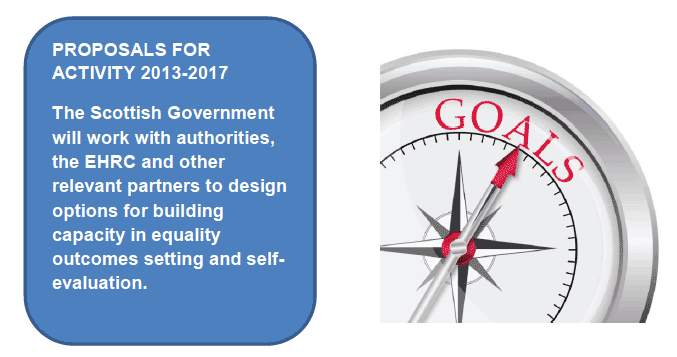
Equality outcomes set and owned by each public authority are important levers for change. Authorities have set, developed and reported on these in different ways. We have recognised that linking equality outcomes to corporate objectives and outcomes, and embedding them into business planning cycles, is important in helping to mainstream equality and make a real difference to the lives of our equality communities.
In 2013 the EHRC found that only 1 in 3 authorities had published robust equality outcomes that were clear and measureable. Many had produced equality outcomes that made it difficult for them to report effectively on their progress by April 2015.
The EHRC identified this as a priority and as part of its commitment to work in partnership with the Scottish Government to support the better performance of the public sector equality duty across Scotland through SNEIP. The EHRC has created the Improving Equality Outcomes Project to work directly with authorities whose equality outcomes would potentially benefit from improvement.
PROGRESS
In June 2014 the EHRC launched a programme of direct support for 46 authorities whose equality outcomes were judged as most likely to benefit from improvement. The programme involved a combination of seminars, peer support, dedicated support from EHRC staff and a self-assessment tool. Following participation in this programme, authorities agreed to produce renewed equality outcomes in October 2014.
The EHRC contracted an independent evaluation of the Outcomes Project, which assessed the overall effectiveness from the perspective of participants. The evaluation and executive summary are available on the EHRC’s website.
Key points of note and lessons learned:
- The timing of support is important – making sure that it comes at the optimum time to have the maximum impact.
- Targeted support with one to one engagement is the most fruitful.
- There may be greater issues for authorities outside of the central belt in terms of their ability to engage and connect with other organisations and access and share good practice.
- Performance measurement is a challenge for smaller organisations. This may be an area in future for more tailored support, training and guidance.
NEXT STEPS
Following the Commission’s monitoring of the 2015 progress reports on equality outcomes, the common areas for improvement include:
- Reports which focus on activity only rather than on outcomes.
- Reports which indicate general progress but do not address progress for people with or who share protected characteristics, who are the intended beneficiaries of the outcome.
- General lack of evidence underpinning progress report with many too general in nature.
The EHRC is planning to use the evidence gathered in “ Measuring Up 4” to develop guidance and support to help public authorities continue to meet the requirements of the public sector equality duty, and will monitor performance of public authorities against reporting requirements in 2017.
Moving forward, public authorities can use this information to examine their own practice and consider what changes they may need to make to ensure that their efforts lead to improved outcomes for their employees and those that use their services. The evidence resources developed by the Scottish Government and set out in Section 2.4 can also help with efforts to develop or revise equality outcomes.
During the SNEIP networking events held between June and October 2015 we also heard that it would be helpful if the next stages of assistance could support themed equality outcomes, allowing public authorities to come together to share experience and practice. This is an interesting suggestion that will encourage more collaborative working and may improve the delivery on outcomes for communities served by a number of authorities.
The Equality and Human Rights Commission will develop further guidance and support to help public authorities
We will explore opportunities to support themed equality outcomes
2.2 PRACTICE SHARING AND KNOWLEDGE TRANSFER
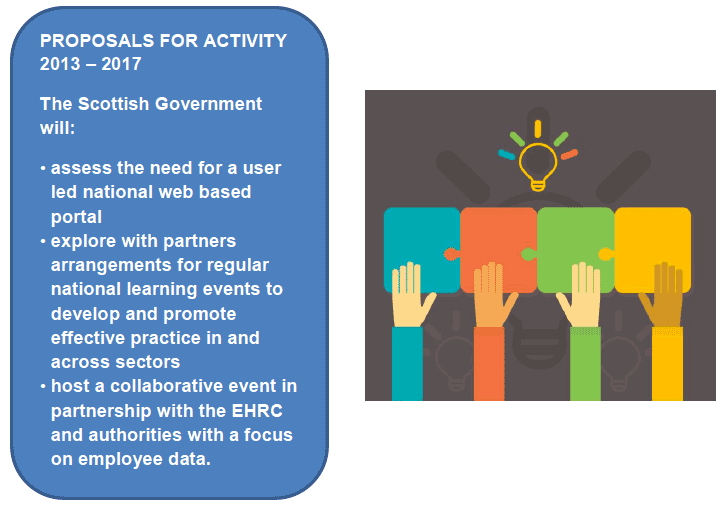
We know from early engagement that there is a strong appetite for collaboration, networking and knowledge transfer across and within sectors. The discussions to date have highlighted the importance of national and local networks working collaboratively across organisational and sector boundaries, sharing knowledge about what works and developing innovative ways of addressing challenges.
PROGRESS
The first phase of this project re-examined the barriers to poor reporting at authority level and the enablers to good practice. This was designed to identify good practice examples for eventual sharing across sectors through events or other mechanisms. The focus of the study was gathering and using employee data and also reporting on gender pay gap and occupational segregation.
The SNEIP partnership followed this work by holding a series of events in 2015 to kick-start collaborative working arrangements and begin to create space for innovative thinking and peer support to improve performance against the Scottish specific employee related equality duties. The events were co-produced and designed and tested with our sounding board partners.
The series was underpinned by a set of agreed principles:
- to reinforce the Scottish Government’s commitment to equality
- to facilitate peer support in a safe learning environment
- to build on the work of existing networks and share collaborative project work
- to share practitioner experience of the 2015 employee related duties.
Public sector equality networks and uniformed services were invited to nominate members from their sectors to participate in the events:
- Scottish Councils Equality Network
- Health Equality and Diversity leads
- The Equality Challenge Unit ( FE/ HE)
- NDPB Network
- Police Scotland
- Fife and Rescue Scotland.
FIRST COLLABORATIVE EVENT
3 June 2015
Our first event was a half-day session held at the Melting Pot, Edinburgh.
The event’s purpose was:
- to share emerging findings from the diagnostic phase of the Project
- for practitioners to share their experience of 2015 reporting duties
- to consider how to work together collaboratively
- to consider the future focus of national improvement activity.
"Our sectors would like some clear guidance on good
reporting, particularly how to report progress rather than
activity"
Event participant
"Please continue with this activity - great to hear from
others"
Event participant
GATHERING AND USING EMPLOYEE INFORMATION
10 September 2015
Our second event was held at Scottish Government’s office in Glasgow. The focus of the event was on improving performance in relation to regulation 6, gathering and using employee information.
The event enabled practitioners to present case studies to demonstrate journeys of improvement and share learning including:
- An NDPB increasing staff declaration rates
- NDPBs working collaboratively to standardise employee data collection
- Health boards working collaboratively to improve workforce data
- A local authority sharing an innovative approach to mainstreaming.
The event was interactive, enabling equality network members to share views and experience through group discussion on the collection of data and how data is used to inform local policy.
"A valuable opportunity to share experiences and learn from
others. A lot of knowledge in the room!"
Event participant
"A national awareness raising campaign to help with
equality monitoring would be very helpful. The campaign should
explain the purpose and value of collecting diversity data."
Event participant
GENDER PAY GAP AND OCCUPATIONAL SEGREGATION
15 October 2015
Our third event was held at a Scottish Government office in Edinburgh. The focus of the event was on regulation 7, the duty to publish gender pay gap information, and on regulation 8, the duty to publish statements on equal pay, including information on occupational segregation.
The Equality Challenge Unit presented their Athena SWAN charter, originally developed to tackle horizontal and vertical gender occupational segregation in Higher Education.
Group discussions focussed on the transferability and use of Athena Swan across sectors.
Close the Gap presented summary findings of its analysis of public authorities’ gender pay gap 2015 reports, which was conducted to supplement the performance reports published by the EHRC. The event provided an opportunity to share the proposed outline of revised guidance to support better reporting of gender pay gap and occupational segregation in 2017. Final guidance will be issued in January 2016.
NEXT STEPS
Feedback from the events indicates that they were very well received, with participants looking forward to a continued programme of knowledge transfer and learning. It is expected that the target audience should be widened in 2016. The feedback also indicates that development of a web portal should be further explored.
Our next steps will be:
Developing and delivering a programme of further learning events
Exploring feasibility of a web portal during 2016
2.3 REPORTING ON PAY GAPS AND OCCUPATIONAL SEGREGATION
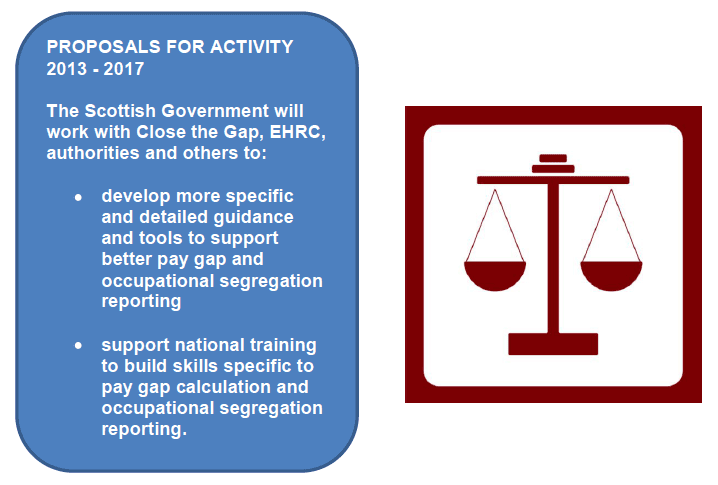
We have a clear ambition to address occupational segregation at all levels across gender, race and disability, and for public authorities to be taking action to reduce inequality and narrow the pay gaps. However, it is clear that a number of public authorities have found difficulty in reporting on pay gaps and occupational segregation.
This work stream began in 2013 with a view that it was necessary to get to the root causes of the problem. What is preventing good quality pay gap and occupational reporting currently? What would drive improved calculation and reporting so that the information can be used to develop fairer workplace policies?
In order to design appropriate improvement support, we first needed to diagnose the problem, mindful that improved quality of reporting occupational segregation between men and women would also help place public authorities in a better position to report on disability and race by 2017.
PROGRESS
Close the Gap carried out a qualitative study to identify barriers to reporting and what works well for public authorities, with a view to identifying good practice examples. The focus of the study was:
- gathering, analysing and using employee data
- reporting on the gender pay gap and occupational segregation
Sectoral focus groups were held with public authorities across further and higher education, local government, NHS boards, NDPBs, and uniformed services.
Common barriers to basic reporting were identified as:
- Old, new or incompatible systems, which created challenges in gathering and analysing employee data
- Low disclosure rates for workforce data
- Challenges in benchmarking against local population data, including a lack of capacity to do this in a meaningful way
- Organisational culture and/or leadership which does not prioritise work on equalities
- Lack of knowledge and understanding of the PSED, the pay gap, occupational segregation, and equalities in general.
The study found that there was confusion from some participants around how to calculate the gender pay gap, and a lack of knowledge and understanding on horizontal and vertical segregation and potential actions that would address each. There was also a limited understanding of gendered barriers to employment and progression. Some participants were relatively new in post and there appeared to be no provision for knowledge transfer.
Enablers to better reporting or what public authorities found useful included:
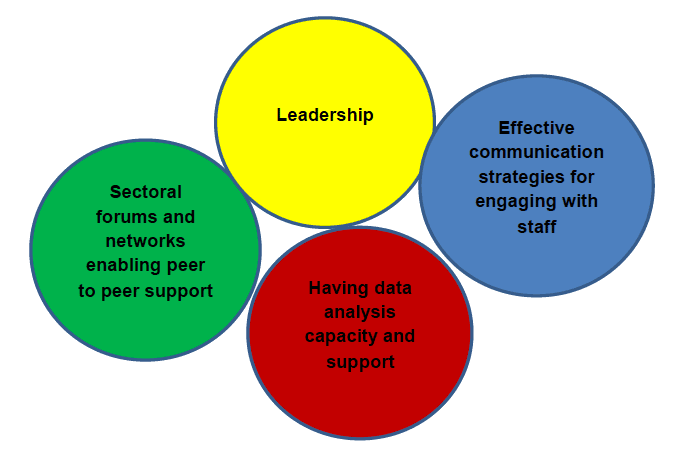
To complement the assessment a series of events from June to October 2015 were held to support collaborative working and support peer to peer learning.
At the SNEIP event in October, the Equality Challenge Unit presented the Athena SWAN Charter, which aims to reduce occupational segregation and promote gender equality in the higher education sector. The aim was to provide examples of actions that can address occupational segregation and other gendered inequalities, and to explore whether the actions were relevant or transferable to other sectors. SNEIP also heard from authorities that additional guidance would help support better pay gap reporting and action on occupational segregation going forward. Close the Gap shared an outline of proposed additional guidance at the October networking event and asked for user feedback.
NEXT STEPS
It is still early in the lifetime of this work stream. However, it is clear from the EHRC’s monitoring and evaluation of the 2015 reports and the supplementary work by Close the Gap in 2014 and in November 2015 that reporting on gender pay gap and occupational segregation has not improved over the last 2 years as we would have expected.
However, through the activity to date we are much clearer about the difficulties that authorities are experiencing and the barriers that have been identified to effective reporting on these matters. By April 2017, we want to see significant movement towards addressing these barriers to poor reporting on the pay gap and occupational segregation of men and women. Furthermore to see evidence of good quality information being used to address inequalities.
The findings of the assessments undertaken and from engagement activity so far indicate that there is a need for continued focus on this area.
Close the Gap’s refreshed guidance will provide detailed information on gathering and using gender-disaggregated data; reporting on and developing actions to address the gender pay gap and occupational segregation; and the benefits of gender equality in the workplace. A short-life working group of public authorities has been set up to inform the development of the guidance.
We are reviewing the feedback from our October learning event to inform what further support is required to help ensure, where possible, improved quality and consistency of reporting on the gender pay-gap and occupational segregation, and prepare the ground for the new reporting requirements on disability and race in 2017.
Our next steps will be:
To develop and clear updated guidance for public authorities on gender and employment, equal pay, and occupational segregation
To continue with plans to deliver capacity building and sessions for public authorities to raise awareness and business knowledge around occupational segregation, the gender pay gap, and disaggregated data gathering
2.4 IMPROVING NATIONAL AND LOCAL DATA AVAILABILITY
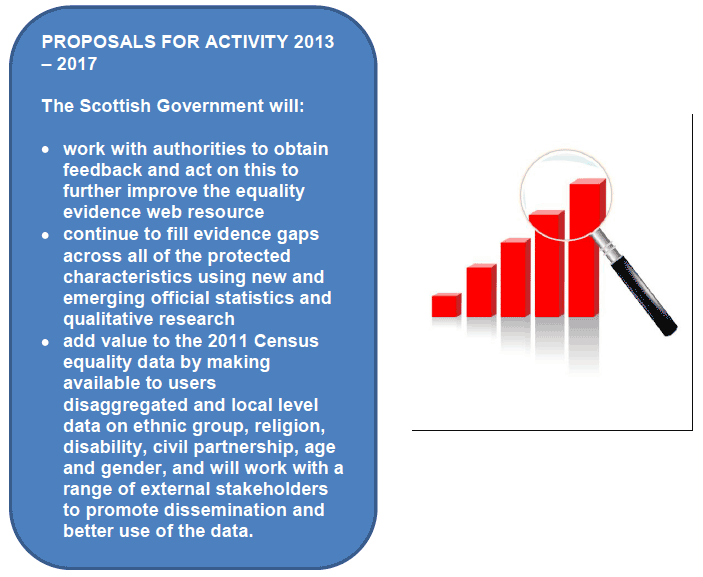
Good use of data and analytical evidence is essential to the proper implementation of the public sector equality duty. Our aim is to help authorities improve their use of equality data.
PROGRESS
Census analysis and equality evidence website
During 2014 and 2015 the Scottish Government carried out a comprehensive equality analysis of the 2011 Census and published the findings to fill evidence gaps on most of the protected characteristics in policy topics, including health, education, housing and the labour market.
This analysis was published as official statistics and the reports are available on the Scottish Government’s equality evidence website.
These reports were designed to be user-friendly, providing easy to digest data visualisations and charts, along with the background data informing these. To date, these reports have been accessed online by users more than 4,000 times.
The analysis presented on the equality evidence website has been used by partner organisations to:
- inform policy making
- inform analytical projects
- provide material for Equality Impact Assessments ( EQIAs)
- provide context for reporting progress against the Scottish specific equality duties.
New equality evidence continues to be added to the Scottish Government Equality Evidence Finder web resource, which is updated biannually.
Involving others
Throughout 2014 the Scottish Government engaged with users of its analysis by hosting, along with the EHRC, a series of Equality Census Data Users meetings where its Census analysis was promoted and discussed. These meetings were attended by equality practitioners across a wide range of sectors, including local authorities, third sector bodies and academia. Users came together to discuss published and planned Census analysis and associated policy priorities.
Equality Evidence Toolkit
In April 2015 the Equality Evidence Toolkit was published on the Scottish Government’s website. This is a practical online resource that public authorities can use to aid their own internal data collection and analysis, and locate national and local equality data for comparisons and benchmarking.
This is a ‘live’ resource designed to be used in each of the PSED reporting cycles. Users in public authorities have been invited to provide feedback on the toolkit, which will shape it over time. It will be updated biannually to ensure that it contains links to the most up-to-date data sources and equality research.
Involving others
In the second half of 2014 Scottish Government analysts met with a range of equality leads within public authorities to discuss what would help them meet the reporting requirements of the Scottish specific equality duties and advance equality in their areas. The sectors contributing to these meetings covered local authorities, health boards, further and higher education and uniformed services.
It was felt that public authorities, particularly smaller ones and those without internal analytical support, would benefit from a practical resource. This resource could help them to locate data from existing evidence sources. It could also contain some guidance on how to use data captured within their own organisations more effectively.
Using the intelligence gathered at this series of meetings, the Scottish Government created a draft version of a practical resource which was aimed at raising awareness of the large amount of equality data already in the public domain and describing how to find it. It also provided guidance on standardised equality questions and recommended that these were asked within organisations. Other sections included one on confidentiality and a summary of useful work published by the Scottish Government’s equality partner organisations.
In December 2014 the Scottish Government promoted a draft version of the toolkit at an event co-hosted by the Scottish Government and CEMVO and used the opportunity for further user feedback.
The Scottish Government also sought feedback on the draft from the authorities who participated in the early development stage of the project and from the SNEIP partnership.
NEXT STEPS
We will modernise the Equality Evidence Finder and make it more engaging for users
We will continue to develop and promote the Equality Evidence Toolkit to support the 2017 reporting duties
Contact
There is a problem
Thanks for your feedback